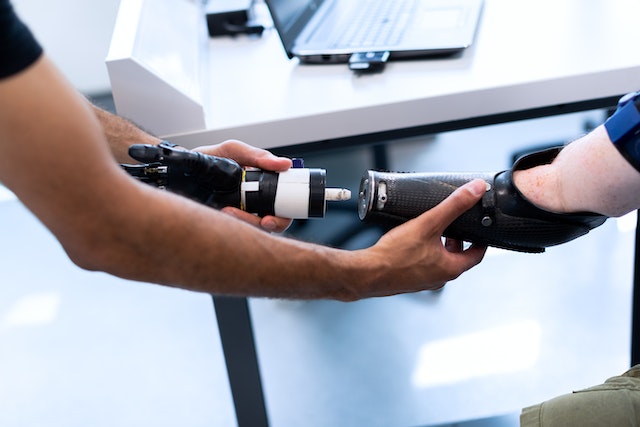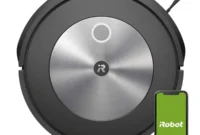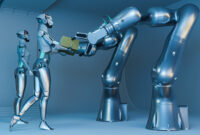The integration of artificial intelligence (AI) and robotics has revolutionized the field of automation, leading to numerous advancements and applications. AI, with its ability to analyze vast amounts of data and learn from it, has enhanced the capabilities of robots, enabling them to perform complex tasks with precision and efficiency. This article explores the profound impact of AI in robotics, discussing its evolution, applications, benefits, challenges, and the future of this exciting field.

Introduction to AI in Robotics
AI in robotics refers to the incorporation of intelligent algorithms and machine learning techniques into robotic systems. It enables robots to perceive and understand their surroundings, make informed decisions, and adapt to dynamic environments. This integration has paved the way for a wide range of applications in various industries, including manufacturing, healthcare, transportation, and space exploration.
The Evolution of Robotics with AI
Early Robotics
Early robotics refers to the initial stages of the development and implementation of robotic systems. These early robots were primarily designed for industrial applications and performed basic, repetitive tasks. They lacked the advanced capabilities and intelligence that AI brings to modern-day robotics.
During this phase, robots were typically programmed using pre-determined instructions and performed tasks in a controlled and structured environment. They were often limited in their ability to adapt to changes in their surroundings or handle complex situations.
Early robots were predominantly used in manufacturing industries, where they performed tasks such as assembly line operations, welding, and material handling. These robots relied on precise programming and mechanical control systems to execute their tasks accurately and efficiently.
However, early robotics laid the foundation for the advancements that would come with the integration of AI. These early robots demonstrated the potential for automation and the benefits of using machines to perform repetitive tasks, leading to increased productivity and reduced human labor.
While early robotics was focused on achieving automation, the incorporation of AI revolutionized the field by introducing intelligence and learning capabilities to robots. The introduction of AI algorithms enabled robots to process and analyze large volumes of data, make decisions based on that data, and adapt their behavior based on the feedback received from their environment.
The evolution from early robotics to AI-powered robotics marked a significant shift in the capabilities of robotic systems. Today, AI-powered robots can perceive their environment using advanced sensors, interpret visual data, recognize objects, and even understand human gestures and speech. They can learn from their experiences, improve their performance over time, and make autonomous decisions in real-time.
Early robotics laid the groundwork for the integration of AI into robotic systems, setting the stage for the rapid advancements and applications we see today. The combination of early robotics and AI has transformed robots into intelligent, adaptable, and versatile machines that can revolutionize various industries and contribute to advancements in automation and technology as a whole.
Integration of AI
The integration of artificial intelligence (AI) into various fields has had a profound impact on technology and robotics is no exception. The integration of AI with robotics has revolutionized the capabilities of robots, enabling them to perform tasks with increased intelligence, adaptability, and autonomy. This integration has opened up new possibilities and applications for robotic systems across industries.
The integration of AI into robotics involves equipping robots with intelligent algorithms and machine learning techniques. These algorithms allow robots to process and analyze vast amounts of data, learn from it, and make informed decisions based on the patterns and insights they extract. This integration has transformed robots from simple machines programmed to perform specific tasks into intelligent systems capable of perceiving and understanding their environment.
One of the key aspects of AI integration in robotics is machine learning. Machine learning algorithms enable robots to learn from experience and improve their performance over time. Through the process of training, robots can analyze data, identify patterns, and make predictions or decisions based on the information they have learned. This ability to learn and adapt allows robots to handle complex and dynamic tasks more effectively.
AI integration in robotics also involves the use of advanced sensors and perception technologies. Robots are equipped with sensors such as cameras, LIDAR, or depth sensors to perceive their surroundings. AI algorithms process the sensor data, enabling robots to recognize objects, interpret visual information, and understand their environment. This perception capability is crucial for robots to interact and navigate within their surroundings accurately.
Furthermore, AI integration enables robots to interact with humans in more natural and intuitive ways. Natural language processing (NLP) allows robots to understand and respond to human speech, enabling them to follow voice commands or engage in conversations. This opens up possibilities for human-robot collaboration and cooperation in various domains.
The integration of AI has also led to advancements in autonomous robotics. Autonomous robots can operate without continuous human intervention, making decisions and taking actions based on their understanding of the environment. This level of autonomy allows robots to perform tasks in complex and dynamic situations, such as autonomous vehicles navigating through traffic or drones performing aerial inspections.
Advancements in Robotics and AI
In recent years, robotics and AI have witnessed remarkable advancements. Robots now possess advanced sensors, enabling them to perceive the world around them more accurately. They can recognize objects, interpret visual data, and even understand human gestures and speech. Moreover, advancements in machine learning algorithms have empowered robots to adapt and respond to unforeseen situations, making them more versatile and autonomous.
Applications of AI in Robotics
AI-powered robots have found numerous applications across various industries. Let’s explore some of the prominent use cases:
Industrial Automation
In manufacturing and industrial settings, robots equipped with AI can automate repetitive and labor-intensive tasks. They can assemble products, handle materials, and perform quality control with high precision and speed. AI-powered robots optimize production processes, reducing costs and increasing productivity.
Healthcare and Medical Robotics
AI plays a crucial role in healthcare robotics. Surgical robots with AI capabilities enable minimally invasive procedures with enhanced precision. AI algorithms analyze medical images and help diagnose diseases more accurately. Additionally, AI-powered robots assist in patient care, rehabilitation, and elderly assistance, improving the quality of healthcare services.
Autonomous Vehicles
Self-driving cars and autonomous drones are prominent examples of AI in robotics. AI algorithms process sensor data to navigate vehicles safely, identify obstacles, and make real-time decisions. Autonomous vehicles have the potential to revolutionize transportation by enhancing road safety, reducing traffic congestion, and increasing energy efficiency.
Space Exploration
Robots equipped with AI are indispensable in space exploration missions. They can withstand harsh environments and perform tasks that are too dangerous or challenging for humans. AI helps robots analyze terrain, collect scientific data, and make autonomous decisions, significantly advancing our understanding of the universe.
Benefits and Advantages of AI in Robotics
The integration of AI in robotics offers several benefits across various domains:
Increased Efficiency and Productivity
The integration of artificial intelligence (AI) into robotics has brought about significant improvements in efficiency and productivity across various industries. AI-powered robots are capable of performing tasks with remarkable speed, precision, and consistency, leading to enhanced operational efficiency and increased productivity. Here’s how the integration of AI in robotics has contributed to these improvements:
1. Automation of Repetitive Tasks
AI-powered robots excel at automating repetitive tasks that were previously performed by humans. By taking over mundane and monotonous tasks, robots free up human workers to focus on more complex and creative endeavors. This leads to increased productivity and efficiency within the workforce as humans can dedicate their time and skills to tasks that require their expertise.
2. Continuous Operation
Unlike humans, AI-powered robots can operate continuously without experiencing fatigue or requiring breaks. They can work tirelessly, performing tasks 24/7 if necessary. This non-stop operation ensures a high level of productivity and output, especially in industries that require round-the-clock production or service delivery.
3. Speed and Precision
AI algorithms enable robots to perform tasks with exceptional speed and precision. They can carry out actions and movements quickly and accurately, reducing processing and execution time. This efficiency in performing tasks translates into increased productivity and output, as more work can be accomplished within shorter timeframes.
4. Consistency and Quality Control
Robots equipped with AI algorithms can consistently execute tasks with a high level of accuracy and repeatability. They follow pre-defined instructions precisely, minimizing the chances of errors or variations in output. This consistency ensures high-quality production and reduces the need for rework or corrections, ultimately improving overall productivity.
5. Optimization and Resource Management
AI-powered robots can optimize processes and resource utilization through data analysis and decision-making. They can analyze vast amounts of data in real-time, identify patterns, and make adjustments to maximize efficiency. This optimization may involve factors such as energy consumption, resource allocation, or production scheduling, resulting in improved productivity and cost savings.
6. Scalability and Flexibility
AI-powered robots offer scalability and flexibility in operations. They can be easily programmed and reconfigured to adapt to changing production demands or new tasks. This flexibility allows for efficient resource allocation and utilization, ensuring that the right number of robots are deployed for specific tasks, further enhancing productivity.
7. Reduction of Downtime and Errors
AI integration in robotics minimizes downtime and errors by enabling predictive maintenance and error detection. Robots can monitor their own performance, identify potential issues, and schedule maintenance or repairs proactively. This proactive approach reduces unplanned downtime and prevents costly errors, ensuring continuous operation and productivity.
Overall, the integration of AI in robotics has significantly increased efficiency and productivity in industries such as manufacturing, logistics, agriculture, and more. AI-powered robots excel at automating repetitive tasks, operating continuously, executing actions with speed and precision, maintaining consistency, optimizing processes, and offering scalability and flexibility. By leveraging the capabilities of AI, organizations can unlock higher levels of productivity, streamline operations, and achieve greater competitiveness in the market.
Improved Accuracy and Precision
The integration of artificial intelligence (AI) into robotics has brought about remarkable advancements in terms of accuracy and precision in various industries. AI-powered robots leverage advanced algorithms and sensor technologies to perform tasks with exceptional precision, minimizing errors and improving overall quality. Here’s how the integration of AI in robotics has contributed to improved accuracy and precision:
1. Advanced Sensors and Perception
AI-powered robots are equipped with advanced sensors such as cameras, LIDAR, and depth sensors that enable them to perceive and understand their environment. These sensors provide robots with detailed and accurate data about their surroundings, allowing them to make informed decisions and perform tasks with precise movements. For example, in manufacturing, robots can accurately detect and grasp objects of varying shapes and sizes, ensuring precise assembly and manipulation.
2. Machine Learning and Pattern Recognition
Machine learning algorithms enable robots to analyze vast amounts of data and learn patterns, leading to improved accuracy and precision in their tasks. Through training and continuous learning, robots can refine their actions and adapt to different situations, making them capable of performing tasks with greater precision over time. This is particularly valuable in applications such as quality control and inspection, where robots can identify defects or anomalies with high accuracy.
3. Real-time Feedback and Adjustment
AI-powered robots can receive real-time feedback from their sensors and adjust their actions accordingly. This feedback loop allows robots to make immediate corrections and achieve precise movements or positioning. For instance, in collaborative robotics, robots can detect the force exerted by a human and adjust their movements to ensure safe and accurate interaction.
4. Integration of Computer Vision
Computer vision, a subfield of AI, enables robots to interpret visual information accurately. Robots can analyze images or video streams to identify objects, recognize patterns, and understand their environment. This capability is particularly useful in applications such as object recognition, navigation, and visual inspection, where robots can achieve high levels of accuracy and precision in their tasks.
5. Calibration and Self-adjustment
AI-powered robots can perform self-calibration and self-adjustment, ensuring precise and accurate operation. They can calibrate their sensors, actuators, and components to maintain optimal performance. This self-adjustment capability reduces the impact of environmental changes or component variations, ensuring consistent accuracy and precision over time.
6. Reduction of Human Errors
Integrating AI in robotics reduces reliance on human operators, minimizing the potential for human errors. While humans may experience fatigue, distractions, or inconsistencies in their performance, AI-powered robots operate with a high level of consistency and accuracy. This reduction in human errors improves overall quality and reliability in tasks such as assembly, welding, or material handling.
7. Optimization and Planning
AI algorithms enable robots to optimize their actions and plan their movements with precision. They can analyze complex scenarios, evaluate multiple options, and choose the most efficient and accurate course of action. This optimization and planning capability ensures that robots perform tasks with the highest level of accuracy and precision while minimizing unnecessary movements or errors.
The integration of AI in robotics has transformed robots into highly accurate and precise machines. Through advanced sensors, machine learning, real-time feedback, computer vision, self-adjustment, and optimization, robots can perform tasks with exceptional accuracy and precision. This improved accuracy and precision have far-reaching benefits across industries, including manufacturing, healthcare, agriculture, and more, where precise operations are crucial for quality, efficiency, and safety.
Enhanced Safety
The integration of artificial intelligence (AI) into robotics has significantly enhanced safety in various industries. AI-powered robots are equipped with advanced sensors, intelligent algorithms, and safety features that enable them to operate in a safer and more secure manner. Here’s how the integration of AI in robotics has contributed to enhanced safety:
1. Collision Detection and Avoidance
AI-powered robots utilize sensors such as cameras, LIDAR, and proximity sensors to detect objects and obstacles in their environment. These sensors enable robots to perceive their surroundings accurately and detect potential collisions. Through real-time analysis of sensor data and intelligent algorithms, robots can proactively avoid obstacles, adjust their movements, and prevent collisions with humans or other objects, ensuring a safer working environment.
2. Risk Assessment and Mitigation
AI algorithms allow robots to assess potential risks and hazards in their operating environment. By analyzing sensor data and contextual information, robots can identify unsafe conditions or situations. They can then take appropriate measures to mitigate risks, such as slowing down or stopping their movements, alerting human operators, or activating safety protocols. This risk assessment and mitigation capability helps prevent accidents and injuries.
3. Safety Interlocks and Monitoring
AI-powered robots are equipped with safety interlocks and monitoring systems to ensure safe operation. These systems can detect abnormal behaviors, excessive forces, or unexpected movements. If a safety breach is detected, the robot can automatically halt its operations or trigger safety protocols to protect humans and prevent potential accidents. This real-time monitoring and response capability enhances safety during robot operation.
4. Collaborative Robotics
Collaborative robots, also known as cobots, are designed to work alongside humans in a shared workspace. They are equipped with advanced safety features, including force and torque sensors, to detect human presence and ensure safe interaction. Cobots can operate at reduced speeds or stop completely when a human gets too close, minimizing the risk of accidents and injury during collaborative tasks.
5. Emergency Stop and Shutdown
AI-powered robots have emergency stop functionalities that allow human operators to quickly halt robot operations in case of emergencies or unsafe situations. Emergency stop buttons or switches are strategically located and easily accessible, enabling immediate intervention to ensure safety. This capability provides humans with a sense of control and the ability to respond promptly to unexpected situations.
6. Predictive Maintenance and Fault Detection
AI integration enables robots to monitor their own performance and detect potential faults or issues. By analyzing sensor data and performance metrics, robots can predict maintenance needs and schedule proactive maintenance. This proactive approach reduces the risk of equipment failures, malfunctions, or safety hazards, ensuring safe and reliable robot operation.
7. Compliance with Safety Standards
AI-powered robots are designed and programmed to comply with safety standards and regulations. These standards address various aspects of robot safety, including risk assessment, design requirements, and operational guidelines. By adhering to these standards, AI-powered robots are built with safety features and behaviors that meet industry-specific safety requirements, reducing risks and ensuring safe operation.
The integration of AI in robotics has transformed the safety landscape by enabling robots to operate in a safer and more secure manner. Through collision detection and avoidance, risk assessment and mitigation, safety interlocks and monitoring, collaborative robotics, emergency stop functionalities, predictive maintenance, and compliance with safety standards, AI-powered robots prioritize safety in their operations. These advancements have led to safer work environments, reduced risks of accidents and injuries, and increased confidence in the use of robots across industries.
Versatility and Adaptability
The integration of artificial intelligence (AI) into robotics has significantly enhanced the versatility and adaptability of robots across various industries. AI-powered robots possess the ability to learn, adapt, and perform a wide range of tasks, making them versatile tools that can address diverse challenges. Here’s how the integration of AI in robotics has contributed to their versatility and adaptability:
1. Task Flexibility
AI-powered robots are capable of performing a variety of tasks with minimal reprogramming or reconfiguration. Through machine learning algorithms, robots can learn new tasks or adapt their behavior based on changing requirements. This flexibility enables robots to be utilized in different applications and industries, such as manufacturing, healthcare, logistics, and more.
2. Autonomous Decision-Making
AI algorithms empower robots with the capability to make autonomous decisions based on real-time data analysis. This allows robots to respond to changing situations and adapt their actions accordingly. For example, in a manufacturing environment, robots can adjust their assembly process based on variations in product specifications or environmental conditions.
3. Learning and Self-improvement
AI integration enables robots to learn from their experiences and continuously improve their performance. Through machine learning techniques, robots can analyze data, identify patterns, and optimize their actions over time. This learning ability makes robots adaptable to changing circumstances, improving their efficiency and effectiveness in performing tasks.
4. Sensor Fusion
AI-powered robots can integrate data from multiple sensors, such as cameras, depth sensors, and force sensors, to gain a comprehensive understanding of their environment. Sensor fusion enables robots to gather rich and diverse information, enhancing their ability to adapt to different situations. For example, in navigation tasks, robots can use sensor fusion to accurately perceive obstacles, determine the best path, and avoid collisions.
5. Human-Robot Collaboration
AI-powered robots are designed to collaborate and interact with humans effectively. They can understand natural language, follow voice commands, and respond to human gestures. This human-robot collaboration allows robots to work alongside humans, leveraging their strengths and adaptability to complement human skills and capabilities.
6. Rapid Reconfiguration and Customization
AI-powered robots can be rapidly reconfigured or customized to perform different tasks or meet specific requirements. By reprogramming or adjusting parameters, robots can quickly adapt to new tasks or environments. This versatility in reconfiguration enables efficient use of robotic systems across a range of applications, reducing the need for specialized robots for each specific task.
7. Multi-Tasking Capabilities
AI-powered robots have the ability to perform multiple tasks simultaneously or sequentially. Through task scheduling and resource optimization, robots can allocate their resources efficiently, allowing them to handle diverse tasks within a single operation. This multi-tasking capability enhances overall productivity and flexibility in various industries.
The integration of AI in robotics has transformed robots into versatile and adaptable machines. Through task flexibility, autonomous decision-making, learning and self-improvement, sensor fusion, human-robot collaboration, rapid reconfiguration, and multi-tasking capabilities, robots can address a wide range of challenges and adapt to evolving needs. This versatility and adaptability make AI-powered robots valuable assets in industries where flexibility, efficiency, and responsiveness are key factors for success.
Challenges and Considerations
While the impact of AI in robotics is significant, there are certain challenges and considerations that need to be addressed:
Ethical Concerns
The use of AI-powered robots raises ethical questions regarding their decision-making capabilities and potential impact on human lives. It is crucial to develop ethical frameworks and guidelines to ensure that robots operate within acceptable boundaries and prioritize human welfare.
Job Displacement
As AI-powered robots automate more tasks, concerns about job displacement arise. While some jobs may become obsolete, new opportunities and roles will also emerge. However, societies need to prepare for this transition by reskilling and upskilling the workforce to thrive in the evolving job market.
Safety and Security Risks
As robots become more autonomous and connected, ensuring their safety and guarding against cyber threats become crucial. Robust safety measures should be implemented to prevent accidents and protect robots from malicious attacks that could potentially harm humans or disrupt critical systems.
Dependence on Technology
As the reliance on AI-powered robots grows, there is a risk of overdependence on technology. It is important to strike a balance between human control and autonomy to ensure that robots serve as tools that augment human capabilities rather than replacing them entirely.
The Future of AI in Robotics
The future of AI in robotics holds tremendous potential for further advancements and innovation. Here are some key areas to watch:
Advancements in Machine Learning
Machine learning algorithms will continue to evolve, enabling robots to learn more efficiently and make better decisions. Ongoing research in areas such as deep learning, reinforcement learning, and transfer learning will contribute to the development of more intelligent and adaptable robots.
Collaborative Robotics
Collaborative robots, also known as cobots, are designed to work alongside humans. Future advancements will focus on enhancing the collaboration between humans and robots, enabling them to complement each other’s strengths and perform tasks more effectively together.
Human-Robot Interaction
Improving the interaction between humans and robots will be crucial for the widespread acceptance and adoption of AI-powered robots. Natural language processing, gesture recognition, and emotional intelligence are some areas of research that aim to make human-robot interaction more intuitive and seamless.
Conclusion
The impact of AI in robotics has been transformative, revolutionizing various industries and expanding the capabilities of robots. With AI-powered robots, we can achieve increased efficiency, improved accuracy, enhanced safety, and adaptability. However, challenges such as ethical considerations, job displacement, safety risks, and technology dependence need to be addressed. The future of AI in robotics promises further advancements in machine learning, collaborative robotics, and human-robot interaction. Embracing this technology while ensuring responsible development will shape a future where robots and humans coexist harmoniously, unlocking new possibilities.
FAQs
How does AI enhance the capabilities of robots?
AI enables robots to analyze data, learn from experiences, and make informed decisions, enhancing their intelligence, adaptability, and autonomy.
What are some applications of AI in robotics?
AI-powered robots find applications in industrial automation, healthcare, autonomous vehicles, and space exploration, among others.
What benefits does AI bring to robotics?
AI in robotics increases efficiency and productivity, improves accuracy and precision, enhances safety, and enables robots to adapt to different scenarios.
What challenges are associated with AI in robotics?
Ethical concerns, job displacement, safety and security risks, and overdependence on technology are some challenges that need to be addressed.
What does the future hold for AI in robotics?
The future of AI in robotics will see advancements in machine learning, collaborative robotics, and human-robot interaction, shaping a future of intelligent and cooperative machines.


